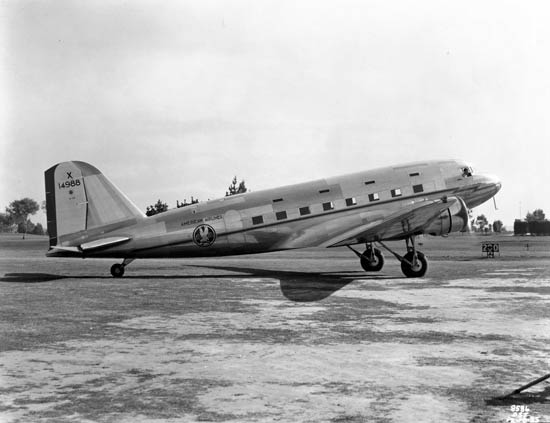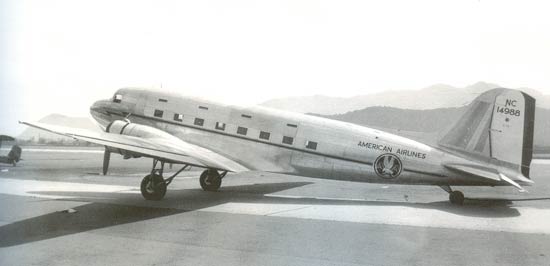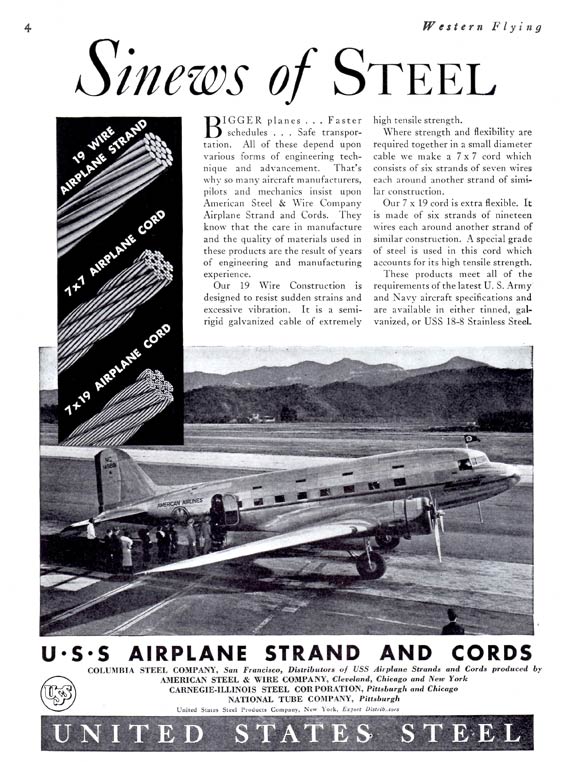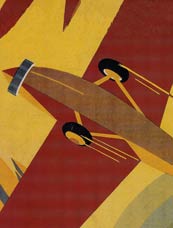|
First Douglas Sleeper Transport
This airplane was the first DC-3 and was configured as the
first Douglas Sleeper Transport (DST). It was manufactured
by Douglas Aircraft Company, Santa Monica, CA as NX-14988
in December 1935 under ATC# 607. It was assigned S/N
1494 with two Wright Cyclone SGR-1820-G-5 engines (S/N R-22863;
L-22862). It was a 31-place airplane. It was test-flown by Register pilot Carl A. Cover.
After testing, it sold to American Air Lines, Chicago, IL
on April 28, 1936 and was approved for “NC” registration
on May 4, 1936 with 112.5 flight hours. A note on the
inspection report dated May 4th states, “The Douglas engineers
inform me that this plane and succeeding planes will be changed
to a 28 [passenger] day type, 14 [passenger] sleeper type,
as soon as the airplane had completed its 100 hr test on
the airline. This should be a week to 10 days.”
It is exactly this time we find NC14988 landing at Tucson. It
arrived May 4, 1936 at 11:21AM flown by Eyer L. “Slonny” Sloniger. Dan
Beard was Slonniger’s co-pilot and they carried eleven
passengers. They were eastbound from Glendale, CA to
Ft. Worth, TX. For posterity, I'll list the passengers here. They were:
Bill Birnen, Hoot Ellis, Bunny Fuller, Bob Johnson, Mike
McMichael (identified as “Stewardess”!), Roy
Mitchell, E.M. Putney, George (Iron Mike) Tate, Jim Kinney
and Messrs. Freeling and Savage. If you have information
about any of these passengers, please let me KNOW. It
was noted in the Remarks column of the Register, "American
Airlines Coast to Coast. Douglas Super Sleeper Transport. First
Flights" and, with huge understatement, "Nothing
to say, much." Below, from the San Diego Aerospace Museum (SDAM), a right profile of the airplane, date and location unknown. Note the American Airlines logo on the fuselage.
Douglas NC14988, Date & Location Unknown (Source: SDAM)
 |
Further paperwork, Form 446 (Repair & Alteration Form),
dated June 30, 1936 indicated, as quoted above, that
this aircraft had been, “…altered to agree with
the latest revised technical data …. and is now a
28 place sleeper transport and is the same as the other DST
airplanes structurally….” Image (cited
in left sidebar) below shows it on the ground in American
Airlines livery just three days before its Tuscon landing.
NC14988, Glendale, CA, May 1, 1936
(Source: AAHS Journal)
 |
Through the rest of 1936-1937 the airplane received new
engines twice and had changes made in avionics (AVR-8C compass installed in cockpit and loop bullet
installed under fuselage). Below, a photograph of NC14988 in an advertisement for aviation-grade twisted cable stock. These cables are used in aircraft mostly to connect flight controls to cockpit pedals and steering wheels that the pilot uses to control the airplane. The location of this image is unknown, but the background mountains look a lot like those in the photo above. Photograph shared with us by site visitor S.B. Sargent.
Douglas NC14988, Western Flying, December, 1937 (Source: Sargent)
 |
A couple of months after the magazine, above, appeared on the news stands, on February 18, 1938 it
suffered an accident at Forrest City, AR when a propeller
struck the ground. The wings were replaced.
It suffered another accident on December 5, 1938 when its
captain, named Andrews, damaged the landing gear and right wing. It
was converted to a 32-place airplane in 1940 and had additional
avionics changes. It was sold to TWA on March 14,
1942 and flew cargo contracts for the Army.
As WWII spooled up, on May 25, 1942 the airplane was sold to the Defense Supplies Corp., Washington, DC, then to the War Department, Washington, DC on July 21, 1942. Its Civil Aeronautics Administration registration was cancelled and it was given USAAF
serial number 42-43619 and operated under U.S. Army insignia. It was wrecked at Knobnoster,
MO October 15, 1942.
---o0o---
THIS PAGE UPLOADED: 06/29/07 REVISED: 11/07/07, 01/18/08, 05/12/09, 06/27/11, 05/09/12
|




